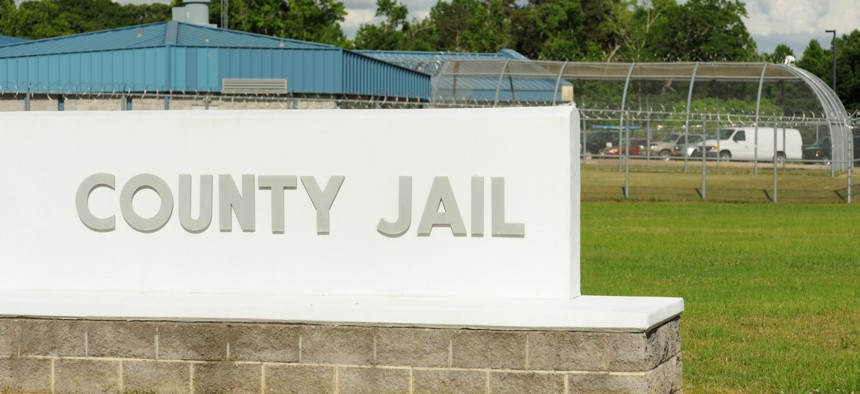Local Corrections Costs Rose by $25 Billion in Last 40 Years

iStock.com/sshepard
But the coronavirus has ushered in creative lower-cost alternative jail programs that could last long after the pandemic, local leaders say.
The cost of local corrections has increased by $25 billion in the last four decades despite drops in both crime rates and jail populations, according to recent research from The Pew Charitable Trusts. But mandated population decreases during the Covid-19 pandemic helped local jails in some jurisdictions find creative cost-cutting measures that could continue long after the threat of the virus has passed, local officials said last week during a webinar hosted by the National Association of Counties.
In Davidson County, Tennessee, for example, officials thinned prisoner populations using citations in place of arrests and relying on “police discretion” to determine who could be monitored safely at home versus inside the jail. Eventually, those methods prompted the larger question of whether the community was incarcerating the correct people in the first place, said Marsha Travis, director of standards and accountability for the Davidson County Sheriff’s Office.
“I really think this will be an open debate for the future,” she said. “If they can be supervised in the community during covid, why can’t they be supervised in the community after covid? It’s really an opportunity for each and every community to evaluate their processes. Who do they have in jail? Do we have the right people in the jail?”
Reducing operating costs in jails can produce significant savings for county governments, which spend more on correctional services than on things like libraries, courts, parks and recreation, fire protection, and water and sewer, according to Pew. In 2017, jail spending made up over 83% of local corrections spending, amounting to about $25 billion in local costs. This increase occurred despite drops in both crime rates and jail populations.
That same year, the most recent year data was available, one out of every 17 county dollars went to jails, accounting for roughly 6% of county budgets across the country, said Tracy Velázquez, manager of criminal justice research for The Pew Charitable Trusts.
“And what we found is that the costs rose even as crime and jail admissions saw double-digit drops,” she continued. Jail spending increased by 13% from 2007 to 2017—from $22 billion to $25 billion—even though “there were 2 million fewer crimes reported to law enforcement during this time.”
Jail admissions dropped by 19% during that same time period, even as prisoner populations remained largely stable due to an increase in the average length of stay. But covid changed that. Once congregate settings were found to dramatically increase the likelihood of virus outbreaks, governors in multiple states mandated reductions in prisoner populations, resulting in a 25% decrease in jails across the country from June 2019 to June 2020, according to data from NACo.
But that didn’t immediately translate to a financial windfall for every jail. In Allegan County, Michigan, for example, jail expenditures increased slightly from 2019 to 2020—by .2%, or $10,369.
“This can be attributed mostly to the need to get additional PPE and cleaning supplies, as well as the increased medical costs,” said Lt. Jim Miller of the Allegan County Sheriff’s Office.
Other jurisdictions have had success reducing costs by examining the criminal justice system as a whole. In Miami-Dade County, that process began by finding a new director of corrections, who started in 2007 by looking at who was in the jail and why.
“It has worked well as an inclusive formula to get answers,” said Miami-Dade County Commissioner Sally Heyman.
At that point, Heyman said, the majority of jail inmates were there for misdemeanors, alongside thousands of others awaiting trial—with plenty of prisoners in both groups plagued by mental health issues. The county tackled each issue individually, using experts in specific fields.
For example, Heyman said, officials began assessing mental health during the jail intake process, then offering alternatives to incarceration, including treatment centers, for certain prisoners. The county also stopped immediate arrests for certain code violations, switching instead to a system of alerts and civil citations.
“They weren’t better for having a criminal arrest,” Heyman said. “We’ve had upwards of an 80% success rate in terms of not having repeat offenders using that method.”
Collaboration is key to that success, Heyman said. Many of the county’s current practices were adapted from similar initiatives from other jurisdictions, and all of them rely on breaking down silos between different agencies and departments.
“We’re open to all kinds of programs,” she said. “It comes from an exchange of information and networking. I don’t think anyone has the best answer. Sometimes it’s just a better answer, or an alternative, and a willingness to be open to best practices.”
Kate Elizabeth Queram is a senior reporter for Route Fifty and is based in Washington, D.C.
NEXT STORY: After a Deadly Year on the Roads, States Push for Safety Over Speed





